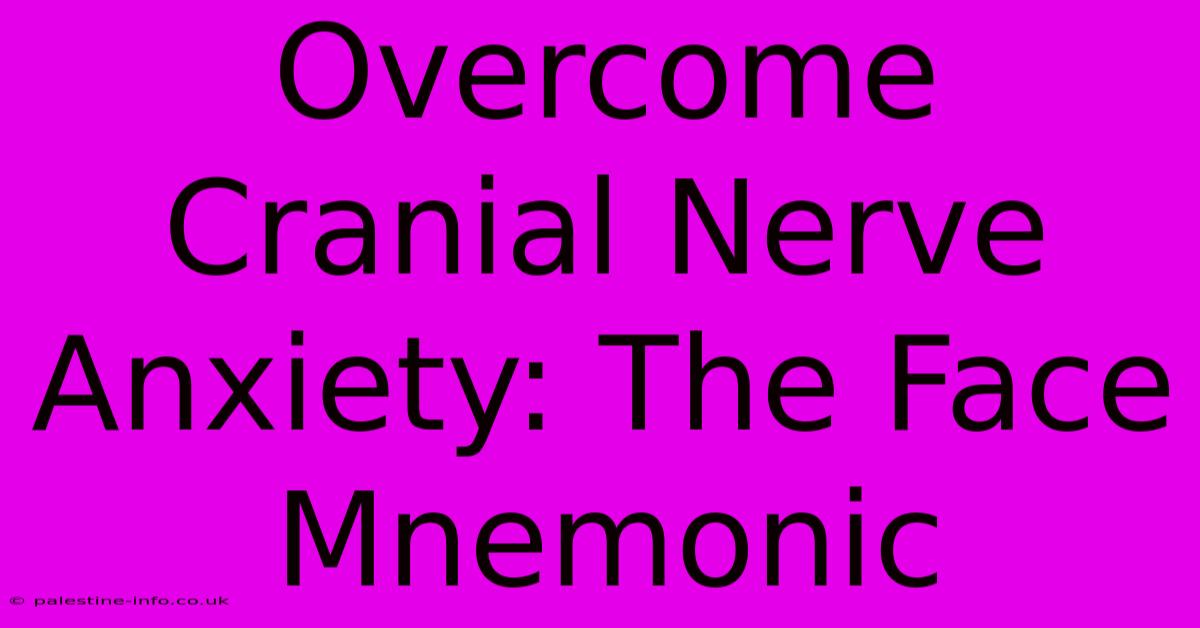Overcome Cranial Nerve Anxiety: The Face Mnemonic

Table of Contents
Overcome Cranial Nerve Anxiety: The Face Mnemonic
Are you a medical student, a healthcare professional, or simply someone fascinated by the human body? Then you've likely encountered the daunting task of memorizing the twelve cranial nerves. For many, this memorization process can trigger significant anxiety. Fear not! This article provides a simple yet effective mnemonic device – focusing on the face – to help you conquer cranial nerve anxiety and master this essential piece of neurological knowledge.
Understanding Cranial Nerve Anxiety
The sheer number of cranial nerves, their varied functions, and the pressure to remember them perfectly can overwhelm even the most diligent students. This anxiety is completely understandable. Forgetting a nerve or confusing its function can have significant implications in clinical settings. But with the right approach, you can transform this anxiety into confident understanding.
Why Memorization is Crucial
Mastering the cranial nerves isn't just about acing an exam; it's a foundational element of neurological assessment and patient care. Understanding their functions allows you to:
- Accurately diagnose neurological conditions: Identifying deficits related to specific cranial nerves is key to diagnosing a wide range of conditions, from strokes to brain tumors.
- Effectively communicate with colleagues: Using precise cranial nerve terminology ensures clear and efficient communication within the healthcare team.
- Provide better patient care: Thorough knowledge of cranial nerves enables you to accurately assess and treat neurological symptoms.
The Power of the Face Mnemonic
Instead of rote memorization, let's leverage a visual and relatable approach: the face. This mnemonic focuses on the cranial nerves' visible effects on the facial region. By connecting the nerves to observable actions or features, you'll build stronger neural pathways and enhance recall.
Visualizing the Cranial Nerves on the Face
Imagine a face. Now, let's associate each cranial nerve with specific aspects of that face:
- Olfactory (I): Think of the nose – responsible for smell.
- Optic (II): Focus on the eyes – responsible for vision.
- Oculomotor (III), Trochlear (IV), Abducens (VI): These three nerves control eye movements. Visualize the complex coordination required for eye movement.
- Trigeminal (V): Think of the sensory innervation of the face. Feel the sensation on your face – touch, pain, temperature. Remember the three branches: ophthalmic, maxillary, and mandibular.
- Abducens (VI): As mentioned above, this controls lateral eye movement.
- Facial (VII): This is your facial expression nerve. Smile, frown, raise your eyebrows – all controlled by this nerve.
- Vestibulocochlear (VIII): Focus on the ears – responsible for hearing and balance.
- Glossopharyngeal (IX), Vagus (X), Accessory (XI), Hypoglossal (XII): While not directly related to the face, these nerves control swallowing, speech, and neck muscles. Imagine the actions involved in speaking and swallowing.
Putting It All Together: Practice and Reinforcement
The key to successful memorization is consistent practice. Here's how to reinforce your learning:
- Active Recall: Test yourself frequently. Don't just passively read; actively try to recall the function of each nerve.
- Flashcards: Create flashcards with the cranial nerve name on one side and its function and facial association on the other.
- Clinical Correlation: Try relating each nerve to clinical scenarios. For example, what might a lesion of the facial nerve present as?
- Group Study: Teaching others is a fantastic way to solidify your knowledge.
Overcoming Anxiety Through Mastery
By adopting this face-focused mnemonic and implementing effective study strategies, you'll not only memorize the cranial nerves but also significantly reduce your anxiety around them. Remember, mastering this material is a testament to your dedication and will build your confidence as a healthcare professional. The key is consistent practice and relating the information to something tangible and memorable – in this case, the face.

Thank you for visiting our website wich cover about Overcome Cranial Nerve Anxiety: The Face Mnemonic. We hope the information provided has been useful to you. Feel free to contact us if you have any questions or need further assistance. See you next time and dont miss to bookmark.
Featured Posts
-
Suicidal Thoughts These Quotes Might Help
Mar 18, 2025
-
Lucys Gift Raising Ada Scid Awareness
Mar 18, 2025
-
Ar 15 General Forum Ask Learn Share
Mar 18, 2025
-
Unleash The Power Browning A5 Turkey Gun Review
Mar 18, 2025
-
How Mansa Musas Hajj Reshaped The World
Mar 18, 2025
